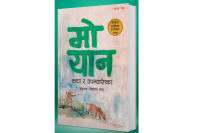Books
Can love be this pure?
Romanticism in ‘The Broken Wings’ might seem distant to modern readers, but the book’s beautiful language makes it unforgettable.
Sanskriti Pokharel
Reading ‘The Broken Wings’ is like drinking a holy drink with a bitter taste. Khalil Gibran’s writing feels like journeying to a beautiful place shadowed by a mournful history, or falling in love with the fear of facing a loss.
Penned by Lebanese-American writer Gibran, ‘The Broken Wings’ is one of those novellas that will compel you to revisit it often, to relish the beauty of sentences penned and comprehend their profundity.
For those yet to read it, the very first paragraph of the book is enough to pull you in. The paragraph goes, “I was eighteen years of age when love penned my eyes with its magic rays and touched my spirit for the first time with its fiery fingers….”
The novella is about star-crossed lovers who are doomed from the very start. The story unfolds simply: two souls meet, fall deeply in love, and are torn apart due to society. Tragedy inevitably follows. But the plot doesn’t make ‘The Broken Wings’ unforgettable. The reason that this book is worth reading is the enchanting and heart-wrenching lines penned by the writer.
The plot’s simplicity is layered with rich figurative language, lyrical prose, philosophy, religious symbols, and deep meanings. Gibran is a dictionary of rich vocabulary. Stating that his mastery of language really shines through would be an understatement.
Gibran has described the story as his own, though it is fictional. As someone who loved a woman dearly but failed to let love see the light of marriage, Gibran has characterised the protagonists in a way that resembles his own love story. It seems the overwhelming emotions of his love for his beloved are mirrored in the novella.
Moreover, his love for his homeland, Lebanon, is also encapsulated in the book. He portrays Lebanon as a beautiful country that can “inspire poets and excite imagination.” He writes, “Spring is beautiful everywhere, but it is most beautiful in Lebanon.” Then follow sentences laden with imagery that make the reader visualise Lebanon carpeted with sheer natural beauty.
Gibran is a keen observer of nature. His use of imagery of flowers, seasons, and light to mirror emotions like love, longing, and loss reveals that he beautifully incorporates elements of nature into his writing.
Also, one particular line, “Solitude is the ally of sorrow as well as companion of spiritual exaltation,” highlights the paradoxical nature of solitude. This line cuts deep. On one hand, solitude can make you feel more sorrow because you're left alone with your thoughts and emotions. But on the other hand, it can also bring peace, clarity, and a deep connection to your inner self, leading to spiritual growth or enlightenment.
This is just an example. Gibran’s writing is rich with reflective lines that linger in our minds, prompting us to pause and consider their profound meanings.
Gibran holds women in the highest regard, both in his writing and in his philosophical outlook. His line, “A woman is to a nation as light is to a lamp,” encapsulates his reverence. Selma, the female protagonist, is not portrayed as a passive figure or a mere love interest in this novella. She is depicted as wise, dignified, and morally elevated. Despite the oppressive forces of patriarchy and arranged marriage, she maintains her integrity and inner strength. Thus, Gibran’s characterisation of Selma is beyond the rigidity of a secondary or supporting character.
Additionally, Gibran characterises the narrator (himself) as a tender, thoughtful and vulnerable man who openly expresses his emotions. He openly mourns the loss of Selma and the cruelty of the world that separated them which was heartbreaking to read.
During Gibran’s time (early 1900s), literature largely portrayed men as rational, strong, emotionally reserved, and action-driven. Male characters were expected to suppress their emotions. Whereas sensitivity was almost exclusively assigned to women. For instance, in Western literature, characters like Hemingway’s protagonists were emotionally withdrawn. In Eastern and Arab literature, men were often authoritative figures such as fathers, warriors, leaders and seldom lovers who weep or showcase their sensitivity.
Gibran, however, offered a new kind of male protagonist: one who felt deeply, loved deeply, suffered deeply and expressed his vulnerabilities deeply. Instead of a ‘Macho man’, this is the kind of male character we want not just in literature and film but also in our life.
Moreover, readers might notice that Selma is often the one who initiates conversations between her and the narrator. Her words come first, followed by his response. While it may seem minor, this choice carries deeper significance. Even in today’s dating culture, societal norms often expect men to take the first step. Yet, in ‘The Broken Wings’, Gibran reverses the traditional gender roles by allowing a woman to lead emotionally.
Having read the book three times before writing this review, my only criticism is that it leans heavily into romance, which isn’t necessarily a flaw. The conversations between Selma and the narrator are intoxicatingly beautiful, excessively sweet and romantic. At times, you cannot help but wonder: Can two people truly love each other this deeply? Does unconditional love like theirs still exist? For a Gen Z reader, their love for each other might feel too good to be true. It can also feel distant from the imperfections of modern relationships.
The Broken Wings
Author: Khalil Gibran
Publisher: Meraat-ul-Gharb
Year: 1912
Pages: 104




 21.02°C Kathmandu
21.02°C Kathmandu














